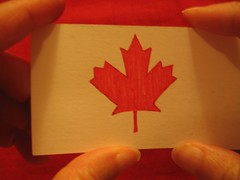Sometime back in January I wrote about the book Daniel Isn’t Talking by Marti Leimbach.
I enjoyed the book and it has been fun watching it appear on store shelves and to see it reviewed, such as last weekend in the Globe and Mail.
I enjoy programs like M&S’s 100 Reader’s Club and Harper Collins’ First Look because they raise the profile of certain titles in my mind. I might have missed or ignored Daniel Isn’t Talking but instead it is like a beacon for me. I see it on bookstands and tell people what a great book it is, I read the reviews and then blog about it. I even read Marti’s blog. I find the insights into her life and her own son’s autism experiences fascinating–sometimes sad but there are moments of triumph that are great to hear about.
I appreciate that I’m not bombarded with books in these programs. I pick the Harper Collins’ books I want to read, and M&S selects a few titles a year that they want large groups of people to read: in fact on Friday I recommended David Bergen’s The Time in Between, which is the first book I read in the M&S club (May 2005 post).
These books stick with me.
As a book reader I love these programs. As a book marketer, I wonder how publishers measure the programs’ value?
I suspect publishers want to see sales lift for the titles in the programs. What I imagine, though, is that sales are not easily correlated to reader program activity. I fear is that publishers will abandon these programs because they perceive the program as a lot of work for very little pay off–pay off being measured only in sales.
So what are the costs? Here’s my imaginary scenario.
By my estimate there’s the cost of the advance reading copy, which could be anywhere from $3-7. Let’s use $5 for this example. Plus the shipping, let’s say $5 per title. Then there’s the admin stuff–staff to oversee the program, mail out the packages, post reviews, etc.–not a wild guess entirely but let’s say it takes one person 8 hours per month to manage the program and we pay them $15/hr. And, we’ll release 4 different titles a year to approximately 100 people each time.
Each title costs $5 + $5 shipping = $10 x 100 people x 4 times per year = $4000
Plus admin costs of $120/month x 12 months = $1440
Total cost to run our imaginary program would be $5440 per year.
Is that a lot?
If a new paperback costs retail $24.95 and we give the bookstore a 50% discount, then we earn $12.48 per title, but we have to pay for the printing, production and overhead costs, plus royalties to the author. Let’s guess our further costs are 50% of that so we earn $6.23 per book. We’d have to sell 873 copies of the book just to cover the cost of our reader program. That’s breakeven, no profits. Then considering the typical volume for a paperback in its first year–3,000-10,000 copies–you can see my fears about “is it worth it?”
It’s hard to guess at the real costs, revenues and profits so I’m open to corrections on the above math.
Regardless, I’d like to argue against only measuring the success of the program by book sales.
I believe that if the publisher can cover the costs of the program then the true value is in the branding of the reader program and the authors involved. Remember the books in these programs stick with me. I have recommended the titles to at least 10 friends. Every book buying survey I’ve ever read shows that book readers are more likely to buy a book recommended by a peer than because of an advertisement in the newspaper. So $5400 could buy a publisher one or two small newspaper ads or 100 people talking about a book they loved and the publisher’s reader program. For $5400, the publisher gets increased recognition of an author name, awareness of the book on store shelves, in reviews and interviews, and recognition of the publisher name.
Brian Quinn in his Thursday newsletter on sales strategies, “Selling the Sizzle” (MediaPost Publications), uses the metaphor of fajitas in a Mexican restaurant. He opens with “Have you ever been to a Mexican restaurant when patrons at the table next to you receive their sizzlin’ fajitas?” You can hear the sound. All eyes in the restaurant turn to check out the “crackling, smoking plate of spicy delights.”
Reader Programs to me are the sizzle in the publishing industry. The right kind of sizzle can mean sales but the huge payoff for the publisher is in brand awareness–increasing their portion of the market’s attention for their targetted books.
With an integrated marketing campaign–single message to multi-channels (book readers, reviewers, booksellers, teachers, librarians)–a publisher can significantly enhance overall brand awareness and relationships with key members of the book-buying population.
I think there is incredible value in the branding opportunities for authors and publishers. What do you think?

